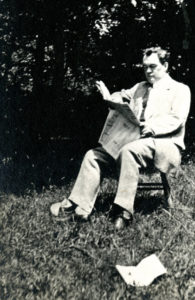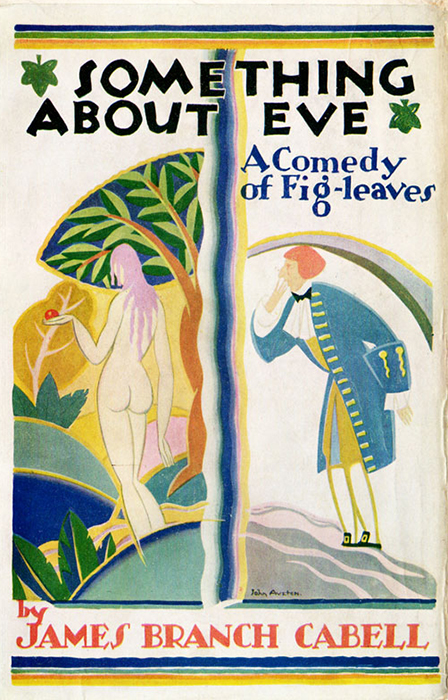If you’re new to an author who’s written more than 50 books, jumping in can be daunting — especially because every reader is a bit different, and one size rarely fits all.
The first thing you should know about James Branch Cabell is that he loved words and all that you could build with them. A well-crafted sentence, a clever allusion and a beautifully-constructed story were his delight. He read widely and assumed his readers did too. Even in his own time, people found his books a challenge. Now, having grown up with a different set of books from this man born in the late nineteenth century, a general reader may need extra persistence to understand why James Branch Cabell was so celebrated by his literary peers.
At the same time, Cabell’s wide-ranging interests and extensive network of friends and activities provide multiple avenues of entry to his writing and to a time of tremendous literary and social change.
Something for everyone
Cabell is often described as a fantasy writer, but if you enjoy non-fiction, there’s something here for you too. Start with Let Me Lie (keeping in mind the double entendre in the title) or As I Remember It, Cabell’s final book.
If you’re interested in the author’s biography, read Edgar MacDonald’s James Branch Cabell and Richmond-in-Virginia.

Special Collections and Archives, VCU Libraries
Cabell was once a newspaper reporter and was close friends with other newspapermen, such as H. L. Mencken and Burton Rascoe. For those who enjoy reading old newspapers, the Library of Congress’ Chronicling America has book reviews, features, society news and publishers’ ads about Cabell and his literary career.
If you enjoy science fiction, you should know that a number of science fiction writers read Cabell and admired his use of tropes and narrative devices. Poul Anderson was one such author; he contributed essays and reviews to Kalki. Robert Heinlein’s Job: A Comedy of Justice gives explicit homage to Cabell, taking its subtitle from Jurgen. Neil Gaiman’s Sandman series contains a library of “novels their authors never wrote or never finished, except in dreams” including a Cabell title, Poictesme Babylon. Larry Nivens wrote a hard sf/horror story “Night on Mispec Moor” (a reference to Cabell’s Something About Eve) and A World Out of Time in which the character “Jerome Branch Corbell” is cryogenically frozen, then revived years later by an oppressive totalitarian government.

Image: Thorne and Lloyd, An Illustrated Bibliography of Works By and About James Branch Cabell
If you’re interested in weird fiction, sword and sorcery fantasy or pulp fiction, that can also be a way into Cabell. Robert E. Howard, creator of Conan the Barbarian, read and admired Cabell’s books, once writing a review of Cabell’s Something About Eve in which he called Cabell the ablest writer of the present age. Howard also mentioned Cabell in several letters.
If you’re a Led Zeppelin fan, you might want to visit VCU Libraries Special Collections and Archives to read Aleister Crowley’s letters to Cabell, and see the adaptation of a Crowley illustration on the cover of Kalki: Studies in James Branch Cabell, vol. IV, no.1 (Winter 1969). Chapter XXII of Jurgen is said to contain elements drawn from Crowley’s Gnostic Mass. Crowley called Jurgen one of the “epoch-making masterpieces of philosophy”
If you’re a book collector, Cabell was too! You can search his personal library or focus on the complexities of the Cabell canon. Cabell’s bibliographers can help you sort out all the revisions, editions and states.

Special Collections and Archives, VCU Libraries
If you’d like to get a quick sense of the sorts of literature Cabell was reading and likely to allude to, look through the epigraphs from his books. Then, for a taste of his writing, read “Before Aesred” (and practice unraveling Cabell’s literary allusions). To sample brief snippets, look at The Quotable Cabell.
If you’re looking for a southern novel, try The Rivet in Grandfather’s Neck or The Cream of the Jest: A Comedy of Evasions (and uncover the hidden message in the Sigil of Scoteia). If you prefer short fiction, you might like “The Casual Honeymoon” from Gallantry, “Tale of the Tenson” from Chivalry or “Concerning Corinna” from A Certain Hour.
If you study women writers, look into Cabell’s correspondence and his ties to writers such as Ellen Glasgow, Marjorie Kinnan Rawlings, Frances Newman, Julia Peterkin, Elinor Wylie, Mary Johnston and Amélie Rives Troubetzkoy. The Virginia Writers Club, founded by Cabell, Shakespeare scholar Orie Latham Hatcher and other Richmond writers, may also reward investigation.
And finally, if you’re intrigued by the story of Don Luis de Velasco, a Native American translator for Spanish explorers in Virginia (who is said to have taken part in a massacre), you might enjoy Cabell’s novel The First Gentleman of America. Follow up with scholar Anna Brickhouse’s discussion of Cabell’s work in The Unsettlement of America. Translation, Interpretation, and the Story of Don Luis de Velasco, 1560-1945.